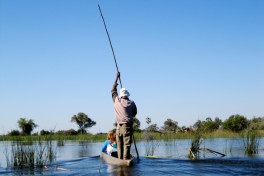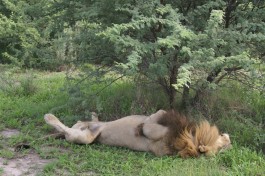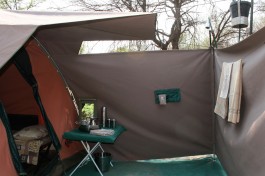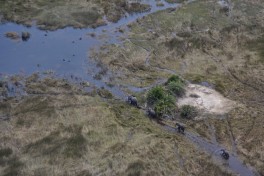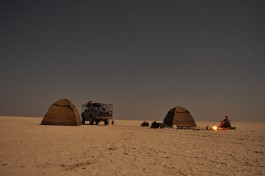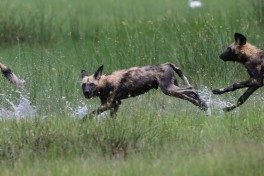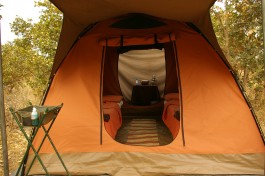10 Day Botswana Mobile Camping Safari to Okavango Delta, Moremi & Chobe
Summary of this Budget Safari Package
On this unconventional mobile camping safari experience an authentic safari as opposed to a luxury lodge safari. As in the early days of safaris, our camp crew moves our safari camp to where our wildlife viewing will take place over ten days.
We explore Botswana’s world-famous wildlife reserves –
- Chobe, known for the huge elephant herds
- the pristine Okavango Delta
- the mysterious Savuti Channel teeming with predators
- and the Khwai flood plains where wild dogs roam.
This mobile camping safari is fully serviced with accommodation in spacious dome tents and ‘al fresco’ en-suite facilities. All guests have to do is relax, enjoy the bushveld and exciting wildlife viewing game drives.
Itinerary for this Tour
Day 1: Maun
On this first day of our mobile camping safari, we are met at the airport by our guide and companion for the next ten days. If you have pre-booked a scenic flight over the Okavango Delta, now is the time to experience it. This is a fantastic introduction to Africa’s wildlife and seen from this perspective highlights the tremendous number of animals that roam this area. The channels snake through the marsh and reveal wallowing hippo and cavorting elephant. An unforgettable experience.
From here we transfer to our tented camp for the night. The camp is deliberately rustic which doesn’t compromise on the comfort or cleanliness but blends with the environment. The intimate camp can only accommodate 16 guests in the eight dome tents set on wooden decks. Each tent has en-suite facilities with showers, a handbasin and a chemical toilet. They are fitted with solar lights, twin beds with comfortable mattresses, pillows, linen and towels. There is a separate lounge area, where guests may play games, birdwatch or just relax with fellow guests.
We spend the evening gathered around the campfire after dinner, getting to know our fellow travellers in the peace of the bushveld under a canopy of stars.
- Meals: Snack Pack & DInner
- Accommodation: Tented Camp
Day 2 & 3: Okavango Area of Moremi
After breakfast this morning we head into Moremi Game Reserve and the Okavango Delta. We spend the day exploring this pristine area teeming with wildlife.
On Day three we take a boat cruise in the Delta which highlights the beauty and serenity of this area.
The Okavango Delta is spread over an area of between six and fifteen thousand square kilometres of Kalahari Desert. Its existence is due to the Kavango River which flows from the Angolan Highlands, across Namibia’s Caprivi Strip and into the harsh Kalahari Desert.
The area is characterised by many small islands, however Chief’s Island, originally the hunting grounds of Chief Moremi, is a much larger tract of land and a popular spot for the wildlife when the water rises.
The Okavango oasis in this otherwise dry area is known for its superb wildlife, with large populations of mammals and excellent birding, particularly in the breeding season. A Botswana treasure, the Okavango Delta has been named one of the natural wonders of the world and is a UNESCO World Heritage Site.
There is an option (own expense) to take a cruise through the channels in a mokoro. Guests are poled, gondolier style, in these dugout canoes getting close to the wildlife and enjoying excellent photo opportunities.
Each evening we return to our mobile camp which has been set up in our absence on day two and dinner which has been prepared by our camp chef. On this fully serviced camping safari, guests need only relax, enjoy the exciting wildlife viewing drives and the scenic bushveld.
- Meals: Breakfast, Lunch & Dinner
- Accommodation: Mobile Camping
Day 4 & 5: Khwai Area of Moremi
After breakfast on day four, our camp is moved to the Khwai Floodplains located in Moremi Game Reserve south-west of Chobe National Park.
The protected ecosystems of Moremi are among the richest and most diverse in Africa. In this 3900 sq kms of reserve, the land merges with the Delta to create floodplains, waterways, lagoons, pools, pans, grasslands and riparian, riverine and mopane forests.
This varied terrain makes wildlife viewing in Moremi extremely exciting. One of the success stories of Moremi Game Reserve is the reintroduction of rhino which was wiped out by poaching, so the reserve can now boast that it is home to the Big 5 of Africa. Moremi is chock full of diverse wildlife and birdlife ensuring enchanting sightings on game drives.
With no fences separating the Khwai Floodplains, nestled between Moremi and Chobe National Park, there is a massive amount of wildlife movement here. Khwai is well known as the area to find wild dog and many other predators.
The Khwai River flows through the area and is a popular spot for hippos, waterbuck and crocodiles, whilst the woodlands support antelope, zebra, buffalo and giraffe. The ubiquitous elephant is here and lion, leopard and hyena are often spotted.
We spend two exciting days here on wildlife viewing drives. Although our days follow a similar formula no two days in the bush are the same.
- Meals: Breakfast, Lunch & Dinner
- Accommodation: Mobile Camping
Day 6 & 7: Savute Area of Chobe National Park
Today we move on to Savute, described as an enchanting place with vast quantities of wildlife roaming the area, but has posed a conundrum over the years. Unsurprisingly Savuti means ‘unpredictable’ a fitting description for this channel that flows like a river and then, inexplicably, dries up. It is thought that these events are caused by the movement of tectonic rock plates beneath the Kalahari Desert, but this is an educated guess.
The impressive landscape is covered with lush vegetation and marshlands, but it wasn’t always like this – until recently the Savuti Channel was dry and the animals relied on artificial waterholes. This fascinating channel runs for 100 kms from the Chobe River to Mababe Depression, where it creates a small marsh.
Although the water is flowing now, who’s to say when it will dry up again – it could be ten years or a hundred years – nature will take its course.
Around November and December and then again between February and April the Zebra migrate with many lion prides hot on their heels. The zebra move from the river in the north to the lush grasslands in the south of Chobe.
Birdlife here is also amazing, with Secretary Birds and Kori Bustards often seen around the Savuti Marsh. Summer migrants and water birds include Abdim’s Storks, Carmine Bee-eaters, Fish Eagles. Red-billed Queleas, which gather in their thousands and are a spectacular sight as they wheel and turn in unison.
This unusual landscape includes the Gubatsa Hills, which were formed millions of years ago during volcanic movement. These hills rise to a height of about 90 meters out of an otherwise completely flat landscape.
We spend two days traversing this amazing landscape on morning and afternoon wildlife viewing drives with our guide.
Evenings are spent around the campfire in true safari style, replete from a three-course dinner prepared by our camp chef and served with South African wines.
- Meals: Breakfast, Lunch & Dinner
- Accommodation: Mobile Camping
Day 8 & 9: Chobe National Park
One of the highlights of our time in Chobe National Park is a boat cruise on the Chobe River.
Chobe is well known for its huge elephant populations and the Chobe River is a popular gathering place for the herds.
In the wet summer season, the birdlife is spectacular as the migrant bird population is in full colour and, with over 450 species having been identified, it is extremely prolific.
This is also the season when antelope start to drop their young. Look out for wallowing hippos and crocodiles as you cruise along the river.
We explore Chobe on game viewing drives in our open safari vehicle, cameras at the ready for the next exciting shot. With only six guests on our open game viewing vehicle, everyone is guaranteed a window seat.
We venture on to the Chobe Floodplains which from the riverside may seem deserted but get into the long grass and the plains come alive with buffalo and elephant herds. Look out for wild dog, lion, leopard, bushbuck, puku, giraffe, cheetah, zebra …… It’s unlikely you will be disappointed.
No safari is complete without a stop for sundowners as we watch the sun sink in the west. In the dry season, the buffalo herds kick up lots of dust which makes for a magical sunset photograph.
Back at camp, we tuck into a welcome dinner and an evening relaxing around the campfire under a canopy of stars.
- Meals: Breakfast, Lunch & Dinner
- Accommodation: Mobile Camping
Day 10: Kasane
Sadly today this mobile camping safari ends after breakfast. Guests are transferred to Kasane Airport.
- Meals: Breakfast
Please note this tour may be taken in reverse order, beginning in Maun and ending in Kasane. It is possible that on occasion two vehicles may be used which will increase the group size.
Image Gallery
Click the image to enlarge
![]()
